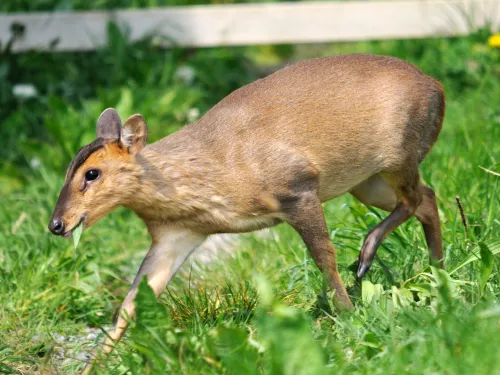
Muntjac deer
The muntjac deer was introduced into the UK from China in the 20th century. It has gained a stronghold in southeast England, where it can cause damage to our woods through browsing.
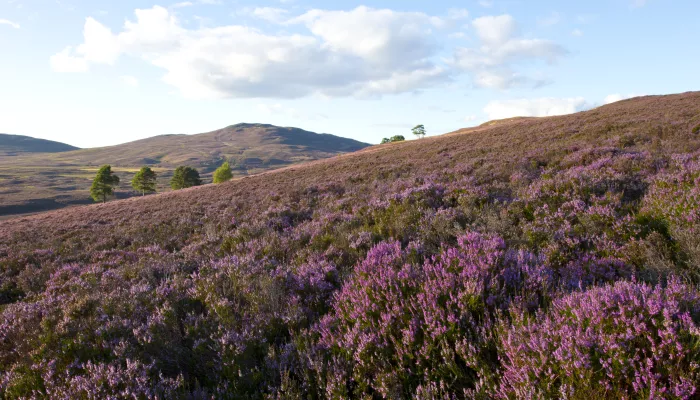
These wild, open landscapes stretch over large areas and are most often found in uplands. Although slow to awaken in spring, by late summer heathland can be an eye-catching purple haze of heather.
One of our most wild-seeming landscapes, heathland has actually been shaped by human actions. It began at least 5000 years ago, when humans started clearing trees growing on infertile soils, probably to entice game into clearings to make hunting easier. Later they used it to graze livestock. In some areas, layers of charcoal show that the forest was cleared repeatedly by fire for grazing or crops. Most heathlands are thought to date from the Bronze Age some 3000 years ago.
Grazing and tree removal caused the nutrient levels to fall further and the soil acidity to increase. These conditions suited heathland plants, which were previously limited to coasts, cliff tops and mountainsides. If undisturbed, heathland naturally develops back into woodland as trees move back in and gradually enrich the soil. However, heathlands became part of the farming system, providing livestock grazing, heather for thatch, turves for fuel, bracken for bedding and potash, gorse for bread ovens and livestock fodder, and sands and gravels for building. Constant disturbance resulted in a landscape that is now valued for cultural reasons as well as its unique wildlife.
Heathland is found from sea level to about 1000m. Low soil fertility means heathland is usually characterised by a small number of plant species, normally dominated by heathers. Despite this, there are major differences in heathland depending on climate, altitude, terrain and wetness, as well as the nature of the underlying substrate.
Upland heath is found over shallow peat and mineral soils in the north and west of the UK, as well as in the southern uplands such as Dartmoor and Exmoor. This is often called moorland, a term also given to other upland habitat such as blanket bog. Lowland heath is found below about 300m on more freely draining sands and gravels.
These are “semi-natural” habitats, requiring human intervention to stop them developing into woodland - the only truly natural types of heathland are montane and maritime heath. Montane heath is found at high altitudes (above about 700m), where exposure prevents the development of taller shrubs or trees. Maritime heath is found on cliff tops, particularly on the Atlantic coast, where strong, salty sea winds keep the vegetation short.
In the lowlands, the decline in the value of heathland to the local economy led to its fragmentation and conversion to other uses. Around 85% of heathland has been lost over the past 150 years through agricultural development and the planting of conifers. The small, fragmented patches that remained fell out of use and natural succession led to the development of secondary woodland, resulting in the loss of many specialist heathland species.
Since then, conservation programmes have sought to reverse the decline of heathlands through management and restoration. Today heathlands are no longer seen simply as wasteland and are valued for their wildlife and cultural history.
In the uplands, the story was different. Moorlands retained close links with agriculture, but from the mid-18th century onwards sheep-rearing became more common. This led to the over-management of upland heathland that we are still struggling with today. Over time large areas of heathland have turned into impoverished grassland. The introduction of trees was also an issue in the uplands, with financial incentives leading to large area of moorland and blanket bog becoming forests.
In recent decades, conservation efforts have done much to reverse the fortunes of heathland. The loss has been halted and restoration projects have increased the area of heathland. Livestock grazing is once again a common sight on larger heathlands, and focussed management seeks to bring many heathland rarities back from the brink of extinction. However, the challenge of how to restore relationships between heathland and local communities remains.
As a charity we rely on memberships. They help us look after over 2,300 nature reserves and protect the animals that call them home.

The muntjac deer was introduced into the UK from China in the 20th century. It has gained a stronghold in southeast England, where it can cause damage to our woods through browsing.

As the UK’s tallest bird the common crane is instantly recognisable with the ruffle of tail feathers and very long legs. Their bugling call is also very distinctive.
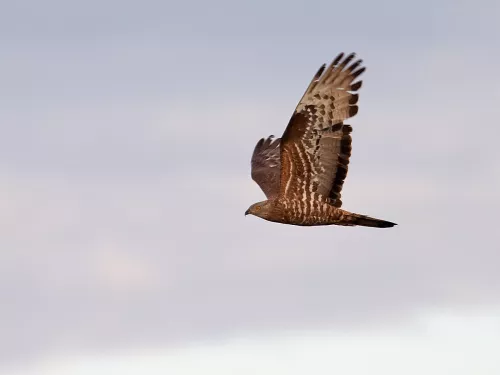
Rare summer visitors, honey buzzards breed in open woodland where they feed on the nests and larvae of bees and wasps.
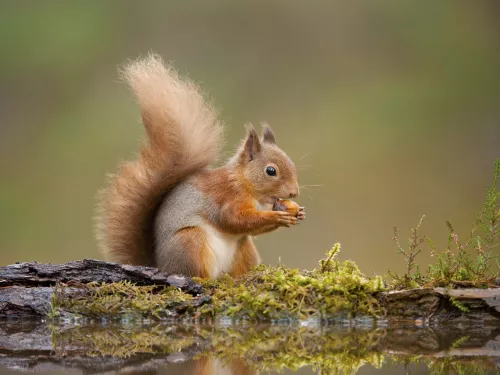
Red squirrels are native to the UK but are a lot rarer than their grey cousins. They live in a few special places across the UK thanks to reintroduction projects.
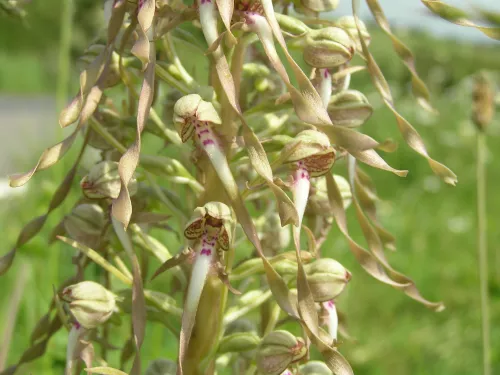
The petals of the rare Lizard orchid's flowers form the head, legs and long tail of a lizard. They are greenish, with light pink spots and stripes, and smell strongly of goats! Spot this tall plant on chalk grasslands and dunes in the South East.
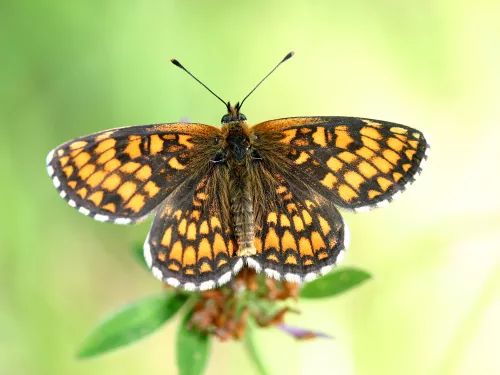
The rare heath fritillary was on the brink of extinction in the 1970s, but conservation action turned its fortunes around. It is still confined to a small number of sites in the south of England, however.
The common green lacewing is a lime green, delicate insect, with translucent, intricately veined wings. It is common in gardens and parks, where it helps to control aphid pests.
A small, tufted fern, maidenhair spleenwort can be found growing out of crevices between rocks, in walls and on mossy branches across the UK.
The wild rock dove is the ancestor to what is probably our most familiar bird - the feral pigeon, which is often found in large numbers in our towns and cities.
Bloody crane's-bill has striking magenta flowers that pepper our rare limestone pavements, grasslands and sand dunes with summer colour. It is a favourite of all kinds of insects, including bumblebees.
Living up to its name, the cherry gall wasp produces growths, or 'galls', on oak leaves that look like red cherries. Inside the gall the larvae of the wasp feed on the host tissues but cause little damage.
Despite its name, Ground-ivy is actually a member of the dead-nettle family. It is a clump-forming, aromatic plant that likes woodlands, hedgerows and damp places.
An uncommon tree of wet woodlands, riverbanks and heathlands, Alder buckthorn displays pale green flowers in spring, and red berries that turn purple in autumn.
The starling is a familiar garden visitor that has a beautiful purple-and-green sheen to its black feathers. It is famous for its wintry aerial displays - massive flocks can be seen wheeling over our towns and farmland.
The stately Grass-of-parnassus displays pretty, white flowers with green stripes. Once widespread, it is now declining as its wetland habitats are disappearing.
The rose chafer can be spotted on garden flowers, as well as in grassland, woodland edges and scrub.
One of our most common butterflies, the meadow brown can be spotted on grasslands, and in gardens and parks, often in large numbers. There are four subspecies of meadow brown.
The palmate newt looks similar to the smooth newt, but favours shallow pools on acidic soils like heathlands. During the breeding season, males grow distinctive black webbing on their hind feet.
The green hairstreak is the UK's only green butterfly. Look out for the vibrant, metallic sheen of the undersides of its wings on grassland and moorland, and along woodland rides.
Looking a bit like a ragged version of a dandelion, mouse-ear hawkweed has lemon-yellow flower heads that are tinged with red at their outer edges. It likes grassy places with short turf and chalky soils.
The Common field grasshopper can be found in sunny, grassy areas, particularly gardens, throughout summer. Males can be seen rubbing their legs against their wings to create a 'song' for the females.
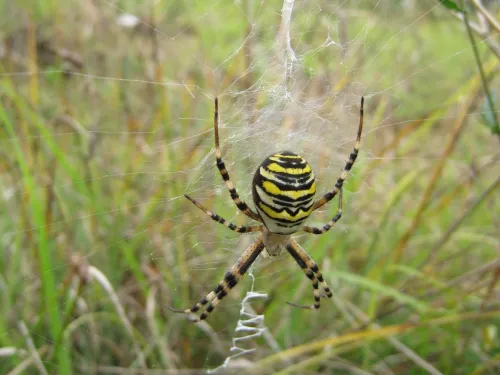
The wasp spider is a great mimic - looking just like a common wasp keeps it safe from predators, even though it is not dangerous itself. It can be found in southern England, but is spreading north.
The jay is a colourful member of the crow family, with brilliant blue wing patches. It is famous for searching out acorns in autumnal woodlands and parks, often storing them for the winter ahead.
The adder's-tongue fern is so-named because the tall stalk that bears its spores is thought to resemble a snake's tongue. An indicator of ancient meadows, it can be found mainly in southern England.
Cock's-foot is a common, tussocky grass of grasslands, woodland rides and cultivated ground - its fluffy, pinky-beige flower heads are quite distinctive.
As its name suggests, quaking-grass can be seen quivering or 'quaking' in a breezy, summer wildflower meadow. Its purple-and-green, heart-shaped flower heads hang from delicate stems.
The scorpion fly, as its name suggests, has a curved 'tail' that looks like a sting. It is, in fact, the males' claspers for mating. It is yellow and black, with a long 'beak'. Look for it in gardens and woods.
With club-shaped leaflets on its fronds, wall-rue is easy to spot as it grows out of crevices in walls. Plant it in your garden rockery to provide cover for insects.
The large, plump woodpigeon is a familiar sight in our gardens and parks, but can also be found on farmland and in woodlands almost everywhere. You may hear its cooing call before you see the bird itself.
Herb-robert is a low-growing plant, with small, pretty, pink flowers. Look for it in shady spots in woodland, hedgerows and coastal areas.
The black garden ant is the familiar and abundant small ant that lives in gardens, but also turns up indoors searching for sugary food. In summer, winged adults, or 'flying ants', swarm and mate.
Often found carpeting damp grassland and woodland clearings, the blue flower spikes of bugle are very recognisable. A short, creeping plant, it spreads using runners.
Wavy hair-grass lives up to its name: its fine, hair-like leaves and delicate flower heads can be seen shaking in the breeze of a windswept moorland or heathland.
The male whitethroat does, indeed, have a white throat! Arriving from Sub-Saharan Africa in April, it can be spotted on grassland and scrub, and along hedgerows. It is bigger than the lesser whitethroat.
A tall plant, Rosebay willowherb is a successful coloniser; it can form dense stands of bright pink flower spikes on disturbed ground, such as woodland clearings, verges and waste ground.
The Coppery click beetle is a large, coppery-purple beetle with straw-brown wing cases. It can be found on grassland and farmland, and its larvae are known to feed on roots and damage crops.
The small heath is the smallest of our brown butterflies and has a fluttering flight. It favours heathlands, as its name suggests, as well as other sunny habitats.
Living up to its name, the long-tailed tit can be easily recognised by its long tail. It is a small, pretty, pink, black and white bird that can be seen in woodlands, gardens and parks.
The small copper lives up to its name in both colour and size! Look out for it from April onwards in dry, sunny habitats like heathland, downland and woodland. It can be spotted in gardens, too.
Dyer's greenweed is a classic plant of hay meadows, heaths and open woodlands. It has upright stems with loose clusters of bright yellow, pea-like flowers in summer.
The meadow grasshopper can be found in damp, unimproved pastures and meadows throughout summer. Males can be seen rubbing their legs against their wings to create a 'song' for the females.
An attractive, green-and-yellow bird, the siskin regularly visits birdtables and feeders in gardens. Look for the bright yellow barring on its black wings, and the black crown of the males.

Standing proud and tall, the red deer is our largest deer. With its massive antlers, it is an unmistakeable icon of the Scottish Highlands, but can be seen in northwest and southern England, too.
Our most familiar fern, bracken can be found growing in dense stands on hillsides, moorland, heathland and in woodlands. It is very large and dies back in winter, turning the landscape orangey-brown.
Toadflax-leaved St John's-wort has star-shaped, bright yellow flowers. It is a rare plant, with most of its population existing on Dartmoor. It likes steep, sunny slopes, acidic soils and plenty of space.
Soft brome is a tall, annual grass of roadside verges, waste ground and meadows, and is a 'weed' of arable land. It has long, grey-green leaves and loosely clustered flower spikes.
Flitting about the house in summer, the gangly, brown daddy longlegs is familiar to many of us. They are a valuable food source for many birds.
A classic fern of woodlands across the UK, the male-fern is also a great addition to any garden. It grows impressive stands from underground rhizomes, dying back in autumn.
The collared dove is a pretty little pigeon that is a regular sight in our gardens, woodlands and parks. Listen out for its familiar cooing call, which you may hear before you see the bird itself.
The small, yellow flowers and woolly appearance of kidney vetch make this plant easy to spot. Look for it growing low to the ground on sand dunes, chalk grasslands and cliffs in summer.
The yellow meadow ant is known for creating anthills in grassland habitats. It has a close relationship with the Chalkhill blue butterfly - protecting the larvae in return for a sugary substance they secrete.
The upright, blue flower spikes of Viper's-bugloss can be spotted on chalk grassland, sand dunes, cliffs and banks. Its spotted stem is thought to resemble a viper.
The fluffy, white heads of common cotton-grass dot our brown, boggy moors and heaths as if a giant bag of cotton wool balls has been thrown across the landscape!
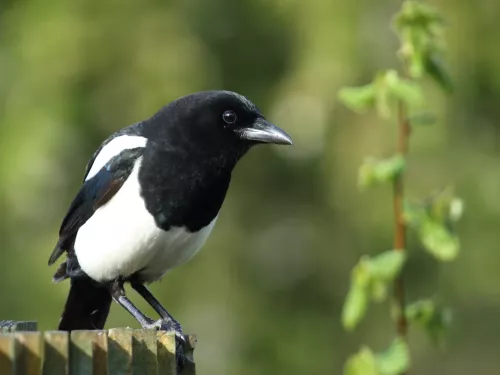
"One for sorrow, two for joy…" is a popular rhyme associated with the magpie - a bird of much myth and legend. An unmistakeable member of the crow family, it can be seen almost anywhere.
Ivy is one of our most familiar plants, seen climbing up trees, walls, and along the ground, almost anywhere. It is a great provider of food and shelter for all kinds of animals, from butterflies to bats.
The common red soldier beetle is also known as the 'bloodsucker' for its striking red appearance, but it is harmless. It is a beneficial garden insect as the adults eat aphids, and the larvae eat other pests.
The stiff, spiky and upright leaves and brown flowers of hard rush are a familiar sight of wetlands, riversides, dune slacks and marshes across England and Wales.
Sphagnum mosses carpet the ground with colour on our marshes, heaths and moors. They play a vital role in the creation of peat bogs: by storing water in their spongy forms, they prevent the decay of dead plant material and eventually form peat.
The Brown argus favours open, chalk and limestone grasslands, but can also be spotted on coastal dunes, in woodland clearings and along disused railways.
The aromatic fragrance of Large thyme can punctuate a summer walk over a chalk grassland. It is an evergreen that grows low to the ground, with erect spikes of tiny, lilac flowers appearing over summer.
The Common green grasshopper can be found in damp meadows and woodland rides throughout summer. Males can be seen rubbing their legs against their wings to create a 'song' for the females.
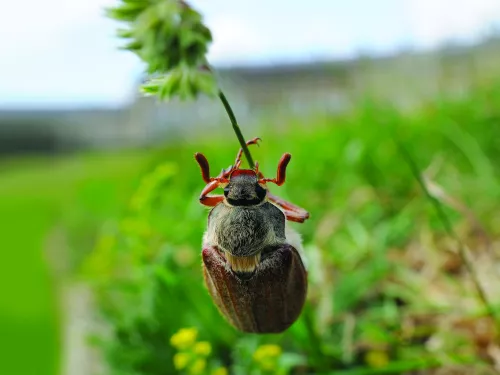
This large, brown beetle can be seen swarming around streetlights in spring. They live underground as larvae for years and emerge as adults often in large numbers. Listen for their characteristic buzzing sound.
As it names suggests, the common crossbill has a large bill that is crossed at the tip - perfect for picking the seeds out of pine cones. Look for it in conifer woodlands, mainly in the north and south.
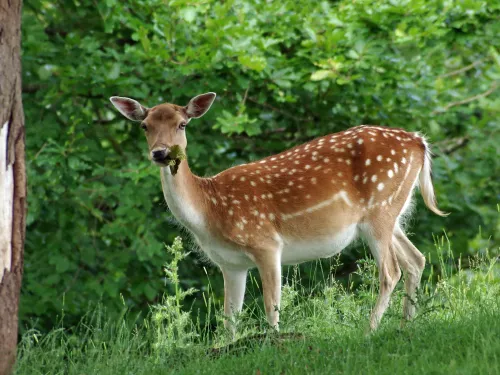
Although introduced by the Normans, the fallow deer has been here so long that it is considered naturalised. Look out for groups of white-spotted deer in woodland glades.
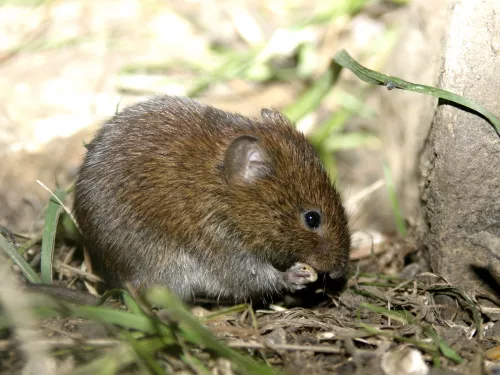
The chestnut-brown bank vole is our smallest vole and can be found in hedgerows, woodlands, parks and gardens. It is ideal prey for owls, weasels and kestrels.
The subject of much myth and legend, and a herbal remedy, Perforate st John's-wort is a familiar flower. It has star-shaped, bright yellow flowers and lots of tiny holes in its leaves that give off a 'foxy' smell.
Flowering in spring, the cylindrical, densely packed flower spikes of Sweet vernal-grass are easily spotted in a meadow. It also tastes of sweet vanilla and was once a favourite 'chewing grass'.
The St Mark's fly is small, black and shiny. It is so-called because it emerges around St Mark's Day, April 25th. Large numbers of adults can be found in woodland edges, hedgerows, fields and wetlands.
Cross-leaved heath is a type of heather that likes bogs, heathland and moorland. It has distinctive pink, bell-shaped flowers that attract all kinds of nectar-loving insects.
The laughing 'yaffle' call of the green woodpecker can be heard in our woodlands, parks and gardens. Look out for it hopping about your lawn, searching for ants to eat.
Look for the small, pink, pea-shaped flowers of Common restharrow on chalk and limestone grasslands, and in coastal areas, during summer.
Turn over large stones or paving slabs in the garden and you are likely to find a Red ant colony. This medium-sized ant can deliver a painful sting, so be careful! In summer, winged adults swarm and mate.
As its name suggests, Deadly nightshade is a highly poisonous plant. Its black, shiny berries may be tempting but fatal. Found on chalky and disturbed ground, such as scrub or verges, it has bell-shaped flowers.
A large hawker, the Common Hawker can be seen throughout the summer and into autumn. A fast-flying insect, it catches its prey mid-air. Look for it around ponds in the uplands of the north and west.
The jackdaw is a small, black-capped crow of woodlands, parks, towns and coast. It is a well-known thief, stealing other birds' eggs and breaking into garden feeders.
Pignut is a small umbellifer, with edible tubers, that is found in woods, hedges and grasslands.
The large eyed ladybird is unmistakeable: it is our only ladybird with yellow rings around its black spots. Ladybirds are beneficial insects, managing garden pests - encourage them by putting up a bug box.
Honeybees are famous for the honey they produce! These easily recognisable little bees are hard workers, living in large hives made of wax honeycombs.
The shy dunnock can be seen hopping about under hedges as its other name, 'hedge sparrow', suggests. It inhabits gardens, woodlands, hedgerows and parks.
The common blue butterfly lives up to its name - it's bright blue and found in all kinds of sunny, grassy habitats throughout the UK! Look out for it in your garden, too.
Windy, open moors covered in bright yellow, spiky common gorse bushes and purple heathers are synonymous with what we call 'wild' landscapes, but it can be seen in many habitats, from coast to town.
The Mottled grasshopper can be found in dry grasslands, such as railway cuttings, and heathlands throughout summer. Males can be seen rubbing their legs against their wings to create a 'song' for the females.
Like many of our farmland birds, the yellowhammer has declined in number in recent years. Spot this bright yellow bird singing from the top of a bush or fence, or in a mixed-species flock in winter.
Like many of our farmland birds, the corn bunting has declined in number in recent years. Spot this streaky brown, thick-billed bird singing from a wire or post - it sounds just like a set of jangling keys!
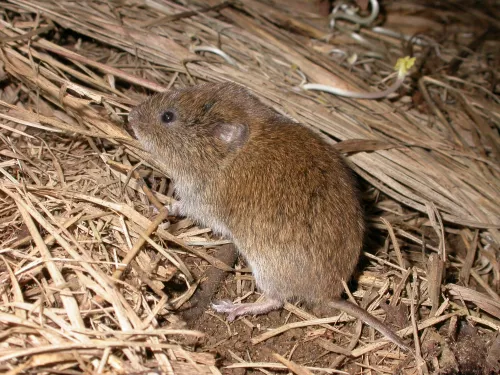
With a population of 75 million, the field vole is one of the UK's most common mammals. Hidden among the vegetation of grassland, heathland and moorland, it is not as easily spotted as the similar bank vole.
Our most familiar wild violet, the Common dog-violet can be spotted in a range of habitats from woodland to grassland, hedgerows to pastures. Its pansy-like, purple flowers appear from April to June.
As its name suggests, creeping bent runs along the ground before it bends and grows upright. It is a common grass of arable land, waste ground and grasslands.
The Downlooker snipefly gets its name from its habit of sitting on posts or sunny trees with its head facing down to the ground, waiting for passing prey. It prefers grassland, scrub and woodland habitats.
Bell heather is our most familiar heather. In summer, it carpets our heaths, woods and coasts with purple-pink flowers that attract all kinds of nectar-loving insects.
Considered to be an early sign of spring, the song of the cuckoo sounds the same as its name: ‘cuck-oo’. It can be heard in woodlands and grasslands. Cuckoos famously lay their eggs in the nests of other birds.
The downy hairs that cover the pale pink flowers of Hare's-foot clover give it the look of a Hare's paw - hence the common name. Look out for this clover around the coast and on dry grasslands.
The most common wood ant is the southern wood Ant, or 'red wood ant', which is found in England and Wales. An aggressive predator, it plays a vital pest control role in our woodlands.
Great mullein is an impressive, tall plant of waste ground, roadside verges and gardens. Its candle-like flower spikes rise from rosettes of furry, silver-green leaves.
A common dragonfly of ponds, lakes and canals near woodland, the Southern Hawker can be seen patrolling the water or 'hawking' through woodland rides. A fast-flying species, it will catch its prey mid-air.
The all-black carrion crow does not nest in colonies like the similar rook. It can be seen almost everywhere.
A low-growing plant of sand dunes, heaths and grassy places, Common centaury is in bloom over summer. Look for clusters of pretty, pink, five-petalled flowers.
One of our most common ladybirds, the black-on-red markings of the 7-spot ladybird are very familiar. Ladybirds are a gardeners best friend as they eat insects that love to nibble on garden plants! You can encourage them into your garden by putting up a bug box.
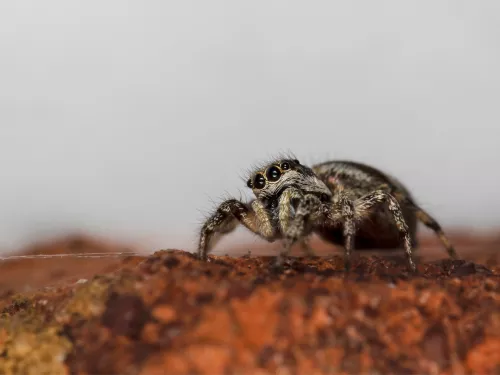
As its name suggests, the zebra spider has the familiar black-and-white stripes of a zebra, making it very distinctive. It can be found stalking its prey on rocks, trees and walls, particularly in gardens.
A very rare species, this moth is now limited to one site in the UK. Males can be a striking reddish buff in colour.
The dark green fritillary is actually an orange butterfly with black spots. It gets its name from the dark green hue to the undersides of its hindwings. A strong flier, it can be seen on open, grassy habitats.
Broom is a large shrub of heaths, open woodlands and coastal habitats. Like gorse, it has bright yellow flowers, but it doesn't have any spines and smells of vanilla.
The Oak bush-cricket is arboreal and can be found in mature trees in woods, hedges, parks and gardens in summer. Males don't have a 'song' as such, but drum on leaves with their hind legs to attract females.

The glow-worm is not actually a worm, but a beetle. Males look like typical beetles, but the nightly glow of a female is unmistakeable - lighting up to attract a mate in the darkness of their grassland habitats. Look for the adults in summer.
A fierce pirate of the sea, the great skua is renowned for stealing fish from other seabirds and dive-bombing anyone that comes near its nests. It breeds on the Scottish Isles.
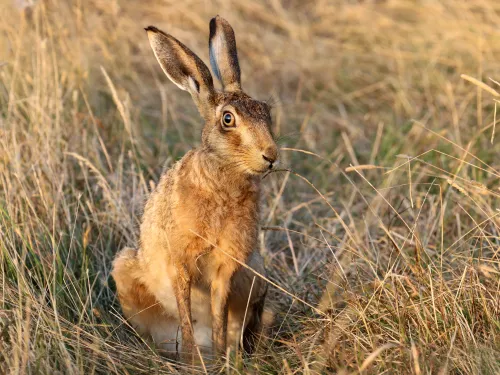
The brown hare is known for its long, black-tipped ears and fast running - it can reach speeds of 45mph when evading predators.
The fluffy, white seed heads of Traveller's-joy give it the evocative, alternative names of 'Old Man's Beard' and 'Father Christmas'. A clematis-like climber, it can be seen scrabbling over hedgerows and in woods.
Timothy is a grass of meadows, arable land, waste ground and roadside verges. It is also cultivated as fodder for livestock. Look for slender stems and long, cylindrical flower spikes in summer.
The Notch-horned cleg-fly isa horse fly dark grey in colour, with grey-brown mottled wings and intricately striped, iridescent eyes. There are 30 species of horse-fly in the UK; this is one of the most frequently encountered species and also one of the smaller ones. Some of us have felt the painful bite of the Notch-horned cleg-fly (a 'horse-fly') while out walking in grasslands or woods, although it prefers to feed on the blood of cows and horses.
Heather is also called 'ling'. Look for it on our heaths, moors and bogs, where its delicate, loosely arranged pink flowers attract all kinds of nectar-loving insects.
Swifts spend most of their lives flying – even sleeping, eating and drinking – only ever landing to nest. They like to nest in older buildings in small holes in roof spaces.
Common bird's-foot-trefoil has a vareity of names that conjure up some interesting images: 'Eggs and Bacon', for instance! Its small, yellow, slipper-like flowers can be seen in all kinds of grassy places.
Wasps are well-known, and unfortunately not very well-loved! But give these black and yellow guys a chance, as they are important pollinators and pest controllers.
The nodding, blue bells of the harebell are a summer delight of grasslands, sand dunes, hedgerows and cliffs. They are attractive to all kinds of insects, too.
A voracious predator that will even eat other dragonflies, the golden-ringed dragonfly is the UK's longest species. It can be found around acidic streams in moorland and heathland habitats.
The linnet can be seen on farmland and heathland across the UK. But, like so many other farmland birds, linnets are declining rapidly, mainly due to agricultural intensification.
Eyebright has small, white flowers with purple veins and yellow centres. It likes short grasslands, from clifftops to heaths, and is one of a number of species and hybrids that are hard to tell apart.
The common name of the Bloody-nosed beetle derives from its unusual defence mechanism: when threatened, it secretes a distasteful blood-red liquid from its mouth. This flightless beetle can be found on grassland and heathland, and along hedgerows.
As its name suggests, the large skipper is bigger than the similar-looking small skipper! It can be seen in summer, resting on the long grass of grasslands, woodlands, verges and sand dunes.
The rare natterjack toad is found at just a few coastal locations, where it prefers shallow pools on sand dunes, heaths and marshes.
The classic fairy tale toadstool, this red and white fungus is often found beneath birch trees in autumn.
The silver-washed fritillary gets its name from the silver streaks on its underside. It is on the wing in summer, preferring sunny glades in woodlands. Despite declines, its range has spread over recent years.
Look for the pinky-white flowers of the dog-rose in summer, and its bright red rosehips in autumn. It is a scrambling shrub of hedgerows, woodlands and grasslands.
The long-winged conehead is so-named for the angled shape of its head. It can be found in grasslands, heaths and woodland rides throughout summer.
The loud 'peep-ing' call of an oystercatcher is a recognisable and familiar sound of the seashore. Look out for it hunting on rocky and muddy shores for shellfish to eat. It can also be spotted on some inland waterbodies where it has started to breed.
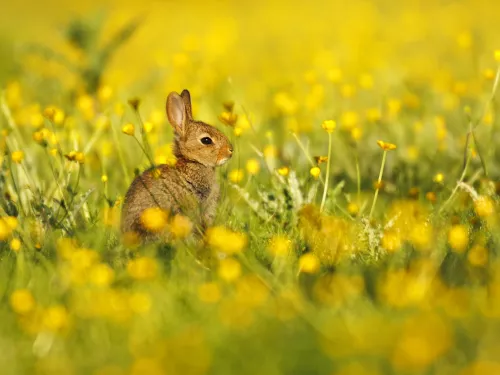
Who doesn’t love spotting rabbits hopping through long grass during a walk in the countryside? They are a common sight but it is always a treat to see their curious faces popping up, ears stood tall on the look out for predators.
Golden banks of common rock-rose make a spectacular sight on our chalk and limestone grasslands in summer. A creeping shrub, it is good for bees, moths and butterflies.
As its name suggests, the smooth stems of soft rush are thinner and more flexible than those of hard rush. It forms tufts in wetland habitats like wet woodlands, marshes, ditches and grasslands.
Many of us have felt the painful bite of the Twin-lobed deer-fly (a 'horse-fly') while out walking in damp grasses or woods. But mostly, it prefers to feed on the blood of cows and ponies, often becoming a pest.
A scrambling 'weed' of waste ground, fields and gardens, Common fumitory can be found on dry and disturbed soils. Its pink flowers appear over spring and summer.
Look out for the swallow performing great aerial feats as it catches its insect-prey on the wing. You may also see it perching on a wire, or roosting in a reedbed, as it makes its way back to Africa for the winter.
A scrambling plant, Tufted vetch has violet flowers. It is a member of the pea family and can be seen along woodland edges, on scrubland and grassland, and at the coast.
The fearsome-looking hornet may not be a well-loved insect, but it is actually much less aggressive than the common wasp. It is also an important pollinator and a predator of species that feed on plants and crops, so can be a gardener's friend.
With its fluffy-looking, light blue flower heads, sheep's-bit is a pretty plant of dry grassland, heaths and clifftops. Sometimes carpeting an area, it is popular with nectar-loving insects.
The Broad-bodied chaser is a common dragonfly that can be seen in summer around ponds and lakes, and even in gardens. It lives up to its name: its flattened body gives it a fat, broad look.
The distinctive rounded wings of the lapwing are displayed beautifully when it wheels around a winter sky in a massive flock. In spring, these flocks disperse and some birds breed in the UK. Listen out for their 'peewit' calls on grasslands and wetlands.
The Foxglove is a familiar, tall plant, with pink flower spikes and a deadly nature. In summer, it can be spotted in woodlands and gardens, and on moorlands, roadside verges and waste grounds.
When threatened, the Green tortoise beetle acts just like a tortoise, pulling its feet and antennae in and hunkering down, gripping the leaf it is on as tightly as possible. Look for it on White Dead-nettle in gardens and hedgerows.
The stonechat is named for its call, which sounds just like two small stones being hit together! It can be seen on heathland and boggy habitats.
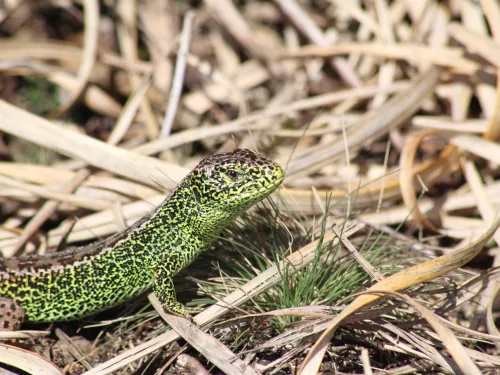
The sand lizard is extremely rare due to the loss of its sandy heath and dune habitats. Reintroduction programmes have helped establish new populations.
The mohawk-sporting caterpillar of this moth is often seen on shrubs and trees in late summer. As adults the orange-brown males fly by day, but the flightless females don't stray far from their cocoon.
The grizzled skipper has a striking brown-and-white checked wing pattern. It is a fast flier, so is best observed in the morning as it basks in the sun to warm up. It favours chalk grassland and woodland habitats.
The wayfaring-tree is a small tree of hedgerows, woods, scrub and downland. It displays creamy-white flowers in spring and red berries in autumn, which ripen to black and are very poisonous.
At nearly 7 cm long (including the female's long ovipositor), the Great green bush-cricket certainly lives up to its name! It can be found in grassland, scrub and woodland rides in Southern England and Wales.
The ringed plover is a small wader that nests around the coast, flooded gravel pits and reservoirs. It is similar to the little ringed plover, but is a little larger, has an orange bill and legs, and doesn't have a yellow ring around its eye.
You are likely to spot the smooth newt in your garden or local pond. It breeds in water in summer and spends the rest of the year in grassland and woodland, hibernating over winter.
Common mallow is a handsome 'weed' of waste ground, roadside verges and gardens. Its deep pink, stripey flowers provide nectar for insects throughout the summer.
Field wood-rush is a short rush that forms tufts in grassy places, such as lawns, parks and downlands. A defining characteristic is its leaf-like leaves that are fringed with long, white hairs.
Our largest and most common bee-fly, the dark-edged bee-fly looks just like a bumblebee, and buzzes like one too! It feeds on flowers like primroses and violets in gardens, parks and woodlands.
The carnivorous lifestyle of the round-leaved sundew makes this heathland plant a fascinating species. The round leaves have sticky, 'dew'-covered tendrils that tempt in unsuspecting insects as prey.
The song of the skylark has been the subject of many great musical and literary works. A quintessential feature of our farmland and grasslands habitats, it is declining rapidly with habitat loss.
A scrambling plant, Bush vetch has lilac-blue flowers. It is a member of the pea family and can be seen along woodland edges and roadside verges, and on scrubland and grassland.
The Tawny mining bee is a furry, gingery bee that can often be seen in parks and gardens during the springtime. Look for a volcano-like mound of earth in the lawn that marks the entrance to its burrow.
Crosswort gets its name from the position of its leaves - they surround the stem in groups of four, making a cross shape. The tiny, yellow flowers sit atop these crosses and bloom from April to June.
The Black darter is a black, narrow-bodied dragonfly that can be seen throughout summer and autumn. It is hovers around damp moors, heaths and bogs, darting out to surprise its prey.
From spring, look out for the beautiful, speckled gold-and-black breeding plumage of the golden plover. It can be found in its upland moorland breeding grounds from May to September, moving to lowland farmland and fields in winter.
The delightful fragrance of wild thyme can punctuate a summer walk over a chalk grassland. It forms low-growing mats with dense clusters of purple-pink flowers.
A regular in gardens, hunting around compost heaps and under stones, the brown centipede is a common minibeast. Despite its name, it has 15 pairs of legs - one on each segment of its body.
A well-travelled migrant, the painted lady arrives here every summer from Europe and Africa. This beautiful orange-and-black butterfly regularly visits gardens.
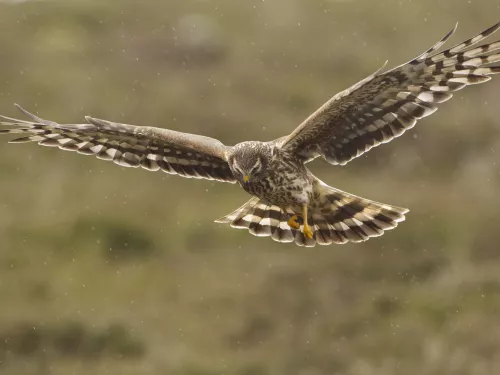
The hen harrier has been severely persecuted for taking game species and has suffered massive declines in numbers as a result. Thankfully, conservation projects are underway to reduce conflict surrounding its controversial prey.
Bilberries appear in summer and early autumn and are often turned into jams, pies and sauces...
The moth-like dingy skipper is a small, grey-brown butterfly of open, sunny habitats like chalk grassland, sand dunes, heathland and waste ground.
The guelder-rose is a small tree of hedgerows, woods, scrub and wetlands. It displays large, white flowers in summer and red berries in autumn, which feed all kinds of birds, including Bullfinches.
The Dark bush-cricket, as its name suggests, is dark brown or reddish. It can be found in woodlands, hedgerows and gardens throughout summer. Its irregular chirpings are a familiar sound of summer.
Found along the coast all year-round, the dunlin is a small sandpiper that breeds and winters in the UK. It can be seen in its upland breeding grounds in summer, when it turns brick-red above and sports a black patch on its belly.
Despite its warts and ancient associations with witches, the common toad is a gardener's friend, sucking up slugs and snails. It is famous for migrating en masse to its breeding ponds.
With its familiar features, the Field pansy is a delicate version of a garden favourite. Usually creamy-yellow in colour, it can be seen in fields and on roadside verges and waste ground.
The soft, downy look of Yorkshire-fog makes it an attractive plant, even if it is considered a weed of cultivated land! It is also attractive to the caterpillars of the Small Skipper butterfly as a foodplant.
With black-and-yellow markings, the Hornet robberfly looks like its namesake, but is harmless to us. This mimicry helps to protect it from predators while it perches in the open, waiting for its own prey.
Hairy bitter-cress is an edible weed of rocky places, walls, gardens and cultivated ground. Gathering wild food can be fun, but it's best to do it with an expert - come along to a Wildlife Trust event to try it.
The secretive woodlark can be hard to spot. It nests on the ground on our southern heathlands and uses scattered trees and woodland edges for lookout posts.
A scrambling plant, Common vetch has pink flowers. It is a member of the pea family and can be seen on grassland, farmland and waste ground, as well as at the coast.
The appearance of semi-circular holes in the leaves of your garden plants is a sure sign that the patchwork leaf-cutter bee has been at work. It is one of a number of leaf-cutter bee species present in the UK.
In summer, the 'frothy' flowers of lady's bedstraw can carpet the grasses of meadows, heaths and coasts with yellow and fill the air with a sweet, honey-like scent.
The Keeled skimmer is a dragonfly of heaths and commons with shallow pools. It has a skittish and weak flight, and is on the wing in summer and early autumn.
The eerie, 'cur-lee' call of the curlew is a recognisable sound of wet grasslands, moorlands, farmland and coasts. Its long, downcurved bill is an unmistakeable feature and perfect for probing the mud for prey.
The Common fragrant-orchid lives up to its name: it produces a sweet, orangey smell that is very strong in the evening. Look for its densely packed, pink flower spikes on chalk grasslands in summer.
Found in compost heaps and under stones in gardens, the White-legged snake millipede is a common minibeast. Despite its name, it has about 100 legs. It is an important recycler of nutrients, feeding on decaying matter.
The Red Mason Bee is a common, gingery bee that can be spotted nesting in the crumbling mortar of old walls. Encourage bees to nest in your garden by putting out a tin can full of short, hollow canes.

Our most diminutive falcon, the merlin is a pretty bird of prey. It chases small birds, flying low to the ground or hovering in the breeze because of its small size. Resident merlins are joined in winter by Icelandic migrants.
This birch-loving moth can be seen flying on sunny days in early spring.
The small pearl-bordered fritillary is a pretty orange-and-brown butterfly of damp grassland, moorland, and open woodland. It gets its name from the row of 'pearls' on the underside of its hindwings.
The Yew is a well-known tree of churchyards, but also grows wild on chalky soils. Yew trees can live for hundreds of years, turning into a maze of hollow wood and fallen trunks beneath dense foliage.
The song of the Roesel's bush-cricket is very characteristic: long, monotonous and mechanical. It can be heard in rough grassland, scrub and damp meadows in the south of the UK, but it is spreading north.
The greenshank breeds on the boggy moors and ancient peatlands of Scotland. But it can be spotted elsewhere in the UK as it passes through on migration - look around lakes, marshes and the coast.
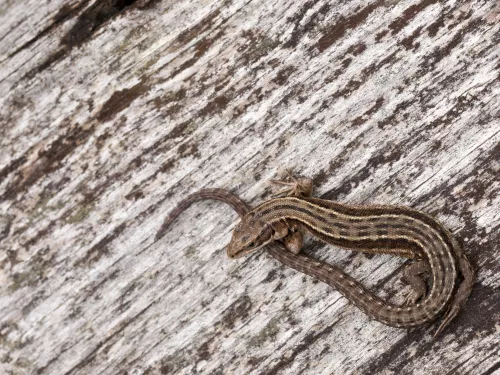
Look out for a common lizard basking in the warm sun as you wander around heathlands, moorlands and grasslands. You might even be lucky enough to spot one in your garden, too!
The stinging nettle is a familiar and common plant, often firmly rooted in our memories after our first, hands-on experience - a prickling irritation that's not forgotten easily!
The Migrant hawker is not a particularly aggressive species, and may be seen feeding in large groups. It flies late into autumn and can be seen in gardens, grasslands and woodlands.
A common hoverfly, the Heineken fly has a distinctively long snout that enables it to take nectar from deeper flowers, reaching the parts other hoverflies cannot reach! It frequents hedgerows, gardens and woods.
An introduced species, Common evening-primrose is now naturalised on waste ground, roadside verges and railway cuttings. It has long been used to produce the herbal remedy, evening-primrose oil.
The meadow pipit favours moorland and grassland. It is an unfortunate victim of cuckolding behaviour - their own young being pushed out of the nest, so they can look after the 'parasitic' Cuckoo chick.
A scrambling plant, Meadow vetchling has yellow flowers. It is a member of the pea family and can be seen on rough grassland, waste ground and roadside verges.
The common carder bee is a fluffy, gingery bumble bee that can often be found in gardens and woods, and on farmland and heaths. It is a social bee, nesting in cavities, old birds' nests and mossy lawns.
A true wildlife 'hotel', Honeysuckle is a climbing plant that caters for all kinds of wildlife: it provides nectar for insects, prey for bats, nest sites for birds and food for small mammals.
The shoulders of the Forest bug are distinctive - they are square-cut, almost rounded, unlike the other 'spiked' shield bugs. This bug can be found in woodlands, feeding on the sap of oak trees.
The whimbrel is very similar to the curlew, but a little smaller and with a striking face pattern. Its eerie call is a series of seven whistles; listen out for it around the coast as its passes through on migration.
Found in compost heaps and under stones in gardens, the Flat-backed millipede is a common minibeast. Despite its name, it only has about 40 legs. It is an important recycler of nutrients, feeding on decaying matter.
If seen up close, the glittering Ruby-tailed wasp is, perhaps, one of the UK's most beautiful insects. A solitary wasp, it can be found in sandy and rocky habitats like quarries, outcrops and walls.
The easiest way to find out if the nocturnal and well-camouflaged nightjar is about is to listen out for its distinctive 'churring' call at dusk. A summer visitor, it is most numerous in southern England.
Considered Britain's most threatened butterfly, the high brown fritillary can be only be found in a few areas of England and Wales.
The dazzling silver-studded blue is a rare butterfly of heathland habitats, mainly in southern England. It has undergone severe population declines in recent years.
A sprawling, spiny evergreen, Common juniper is famous for its traditional role in gin-making. Once common on downland, moorland and coastal heathland, it is now much rarer due to habitat loss.
Despite popular belief, and its name (from the Old English for 'ear beetle'), the Common earwig will not crawl into your ear while you sleep - it much prefers a nice log or stone pile! It feeds on organic matter, recycling important nutrients.
Sometimes known as the snipe of the woods, the exquisitely camouflaged woodcock is mainly nocturnal, hiding in the dense undergrowth of woodlands and heathlands during the day.

Despite appearances, the slow worm is actually a legless lizard, not a worm or a snake! Look out for it basking in the sun on heathlands and grasslands, or even in the garden, where it favours compost heaps.
Common mouse-ear is a persistent 'weed' of fields and gardens, verges and hedgerows - all kinds of habitats. But, like many of our weed species, it is still a good food source for insects.
The Four-spotted chaser is easily recognised by the two dark spots on the leading edge of each wing - giving this species its name. It can be seen on heathlands and near ponds and lakes.
The Common banded hoverfly has a fitting name: it is not only one of our most common species, its black body is also covered in yellow bands! It can be seen in many habitats from gardens to woodlands.
The carnivorous lifestyle of common butterwort makes this heathland plant a fascinating species. Its leaves excrete a sticky fluid that tempts unsuspecting insects to land and become its prey.
A scarce and declining bird, the tree sparrow can be spotted on farmland and in woodlands; it is not an urban bird in the UK. It has a brown cap and black cheek-spots, unlike the similar house sparrow.
As its name suggests, Meadowsweet is a sweet-smelling flower of damp meadows, ditches and riverbanks. Look for frothy clusters of cream flowers on tall stems.
Living up to its name, the red-tailed bumblebee is black with a big, red 'tail'.
The brown, oval, spiky seed heads of the teasel are a familiar sight in all kinds of habitats, from grassland to waste ground. They are visited by goldfinches and other birds, so make good garden plants.
With yellow-and-black bands, the giant horntail looks like a large wasp, but is harmless to us. The female uses her long, stinger-like ovipositor to lay eggs in pine trees, where the larvae then develop.
Listen out for the 'drumming' sound of a male snipe as it performs its aerial courtship display. It's not a call, but actually its tail feathers beating in the wind. Snipe live on wet grassland, marshes and moorlands throughout the UK.
The common spotted-orchid is the easiest of all our orchids to see: sometimes, so many flowers appear together that they create a pale pink carpet in our woodlands, old quarries, dunes and marshes.
The defensive mechanism of the pill woodlouse is very recognisable - it curls itself into a tight ball, only showing its plated armour to its attacker. It is an important recycler of nutrients, feeding on decaying matter.
The large, fluffy caterpillars of this moth are often seen in summer and early spring.
The tiny wren, with its typically cocked tail, is a welcome and common visitor to gardens across town and countryside. It builds its domed nests in sheltered bushes and rock crevices.
The puss moth is a large and fluffy moth, with a very strange looking caterpillar.
The six-spot burnet moth is a day-flying moth that flies with a slow, fluttering pattern. Look for it alighting on knapweeds and thistles in grassy places. It is glossy black, with six red spots on each forewing.
A spindly tree of heathland and moorlands, and dry and sandy soils, the Silver birch is well known for its paper-thin, white bark. It is a great coloniser and can quickly spread in an area.
Our largest shieldbug, the red-and-green hawthorn shieldbug can be seen in gardens, parks and woodlands, feeding on hawthorn, rowan and whitebeam. The adults hibernate over winter.
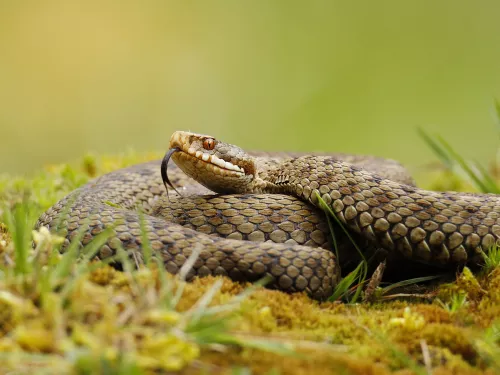
Our only venomous snake, the shy adder can be spotted basking in the sunshine in woodland glades and on heathlands.
Common sorrel is a common plant of grasslands, woodland edges, roadside verges and gardens. It is also known as 'sour ducks' because its leaves taste tart.
The Common darter is a red, narrow-bodied dragonfly that can be seen throughout summer and autumn. It is hovers around all kinds of waterbodies, darting out to surprise its prey.
With brown-and-orange markings, the Drone-fly looks like a male Honeybee, but is harmless to us. This mimicry helps to protect it from predators while it searches for nectar in gardens and urban areas.
The yellow, star-like flowers of bog asphodel brighten up our peat bogs, damp heaths and moors in early summer, attracting a range of pollinating insects.
The song thrush is a familiar garden visitor that has a beautiful and loud song. The broken shells of their blue, spotty eggs can often be found under a hedge in spring.
The bramble is the thorny shrub of hedges, woods and scrub that gives us delicious blackberries in autumn. Gathering wild food can be fun, but it's best to do it with an expert - come along to a Wildlife Trust event to try it.
Living up to its name, the white-tailed bumblebee is black-and-yellow bee with a bright white 'tail'. A social bumble bee, it can be found nesting in gardens and woods, and on farmland and heaths.
A renowned 'weed' of paddocks, pastures and waste ground, the yellow flower heads of common ragwort are actually highly attractive to bees and other insects, including the cinnabar moth.
The tawny grisette has an orange-brown cap and a tall, slender stem that arises from a conspicuous cup-like sack. It can be found in woodlands, particularly those with Birch, but also on heaths.
The clouded yellow is a migrant that arrives here from May onwards. Usually, only small numbers turn up, but some years see mass migrations. It prefers open habitats, particularly chalk grassland.
As its name suggests, Red bartsia does have a red tinge to its stem, leaves and small flowers. Look for it on roadside verges, railway cuttings and waste ground in summer.
If you were to pick up a rock in the garden, you’d hopefully find a few common woodlouse. These hardy minibeasts have in-built armour and like to hide in warm, moist places like compost heaps.
A common moth across most of the UK. The large, hairy caterpillars are often seen in late summer.
As the name suggests, the male blackcap has a black cap, while the female has a gingery one. Look for this distinctive warbler in woodland, parks and gardens.
This streaky brown bird is a summer visitor to Britain, favouring open woodlands in the north and west.
An unmistakeable insect of heaths, sand dunes and grasslands, the Emperor moth is fluffy, grey-brown, with big peacock-like eyespots on all four wings. Males can be seen during the day, but females lie low.
A spindly tree of heathland and moorlands, and damp soils, the Downy birch is well known for its paper-thin, white bark. It is so-called for the hairy stalks from which its leaves grow; the Silver Birch is hairless.
As its name suggests, the birch shieldbug can be found feeding on silver birch, and sometimes hazel, in mixed woodland. Adults hibernate over winter, emerging in spring to lay their eggs.
The marsh hair moss is the largest moss in the UK. Look out for it in damp woodland and on boggy heathlands where it forms large, green and spikey 'cushions'.
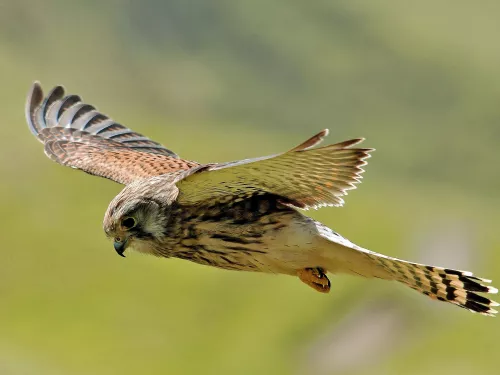
The kestrel is a familiar sight hovering over the side of the road, looking out for its favourite food: small mammals like field voles. It prefers open habitats like grassland, farmland and heathland, but can be seen in towns and villages.
Look for the delicate, pink flowers of Common bistort in wet meadows, pastures and roadside verges. It is also known as 'Pudding Dock' in North England because it was used to make a dessert at Eastertime.
Living up to its name, the Robin's pincushion is a red, round, hairy growth that can be seen on wild roses. It is caused by the larvae of a tiny gall wasp that feeds on the host plant, but causes little damage.
With ginger hairs, dark banding and a cream tail, the Narcissus bulb fly looks like a bumble bee, but is harmless to us. This mimicry helps to protect it from predators while it searches for nectar in gardens.
Common cow-wheat is a delicate annual that brightens up the edges of acid woodland and heaths with deep golden flowers in the summer.
The mistle thrush likely got its name from its love of mistletoe - it will defend a berry-laden tree with extreme ferocity! It is larger and paler than the similar song thrush, standing upright and bold.
The Wild strawberry produces miniature, edible versions of the juicy red fruits we so enjoy. Gathering wild food can be fun, but it's best to do it with an expert - come along to a Wildlife Trust event to try it.
A ferocious and agile predator, the green tiger beetle hunts spiders, ants and caterpillars on heaths, grasslands and sand dunes. It is one of our fastest insects and a dazzling metallic green colour.
The wall brown or 'wall' gets its name from the fact it rests on any bare surface or wall! It can be found in open, sunny places like sand dunes, old quarries, grasslands and railway cuttings.
Despite having the familiar sage-green leaves, Wood sage has very little scent, so is not a good cooking herb. It can be found on acidic soils on sand dunes, heaths and cliffs, and along woodland rides.
The large white is a common garden visitor - look out for its brilliant white wings, tipped with black.
A common thistle of roadside verges, rough grassland and waste ground, the Musk thistle has large, purple, nodding flower heads that appear in summer. It is attractive to a wide range of insects.
The Common harvestman is familiar to us as the large, spindly spider-like creature that frequents gardens and houses. It predates on smaller invertebrates which it catches using hooks on the ends of its legs.
These moths can be seen flying on sunny days, but you're more likely to spot the fuzzy caterpillars crawling over paths.
A plain-looking warbler, the garden warbler is a summer visitor to the UK. It is a shy bird and is most likely to be heard, rather than seen, in woodland and scrub habitats.
This small finch nests on moorlands and coastal crofts, spending the winter on the coast. The UK population has declined dramatically.
These pretty black and red moths are often confused for butterflies! Their black and yellow caterpillars are a common sight on ragwort plants. The caterpillar’s bright colours warn predators not to eat them, giving a strong signal that they are poisonous!
Common whitebeam is not a common tree, despite its name. It can be found growing wild in a variety of habitats, but is also planted in towns and gardens. Look for shiny, oval leaves with white undersides.
The Parent bug lives up to its name. The female lays her eggs on a Silver birch leaf, watching over them until they hatch. She stays with the young until they are adults. Other shield bugs lay their eggs and leave.
Fir clubmoss is a primitive plant found in rocky, moorland and mountain habitats. The stems of this tufted, upright fern look like tiny conifers.

Like many of our birds of prey, the peregrine falcon was so persecuted, numbers fell dramatically. Thankfully, this super-speedy flyer is now making a comeback, particularly in our towns, where it nests on tall buildings.
The dark-blue flowers of Common milkwort pepper our grasslands from May to September. It can also appear in pink and white forms.
The common spangle gall wasp produces a small, disc-shaped growth, or 'gall', on the undersides of oak leaves. Inside the gall, the larvae of the wasp feed on the host tissues, but cause little damage.
The Heath bumblebee is not only found on heathland, but also in gardens and parks. It nests in small colonies of less than 100 workers in all kinds of spots, such as old birds' nests, mossy beds and even roofs!
The Scots pine is the native pine of Scotland and once stood in huge forests. It suffered large declines, however, as it was felled for timber and fuel. Today, it is making a comeback - good news for the wildlife that depends on it.
A summer visitor to the UK, the red-tailed redstart is a robin-sized bird that can be spotted in woodlands, parks and hedgerows, mainly in the north and west of the UK.
As its name suggests, Silverweed has silvery leaves with toothed edges. It can be found in grassy places, along roadsides and on waste ground - look for yellow, saucer-shaped flowers and red runners.
The Common sexton beetle is one of several burying beetle species in the UK. An undertaker of the animal world, it buries dead animals like mice and birds, and feeds and breeds on the corpses.
The striking black-and-white checks of the marbled white are unmistakeable. Watch out for it alighting on purple flowers, such as field scabious, on chalk and limestone grasslands and along woodland rides.
The bright blue, trumpet-shaped flowers of the marsh gentian contrast deeply with the pinks and purples of the wet heaths it inhabits. The New Forest holds a large population of this late-flowering plant.
The small white is a common garden visitor. It is smaller than the similar large white, and has less black on its wingtips.
Look for the round, cottony, purple flower heads of the Woolly thistle on chalk and limestone grasslands in summer. It is mainly found in Southern England.
Have you ever stopped to look at the shape of a spider web? Garden spiders spin a spiral shaped web, perfect for catching lots of juicy prey!
This shiny beetle is common in wooded areas throughout the UK. As the name suggests, it specialises in hunting snails.
A summer visitor, the willow warbler can be seen in woodland, parks and gardens across the UK. It arrives here in April and leaves for southern Africa in September.
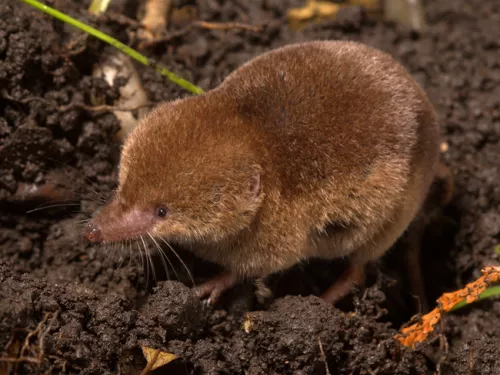
The diminutive common shrew has a distinctively pointy nose and tiny eyes. It lives life in the fast lane, eating every 2-3 hours to survive, and only living for a year or so. Look out for it in the garden.
Found almost everywhere, the large yellow underwing is a night-flying moth that is often attracted to lights. It is brown with orangey-yellow hindwings.
A familiar shrub of hedgerows and woodland edges, blackthorn comes alive in spring when it bursts into a froth of white blossom. It is well known for its sloes, too - the blue-black fruits used in sloe gin.
The spiked shieldbug has fearsome shoulder projections or 'spikes' and a predatory nature. This brown bug feeds on caterpillars and other insects in woodlands and on heathlands.
The common polypody is a hardy fern of damp, shady places in woodlands. It also makes a good garden fern. It has ladder-like, leathery foliage with pimply undersides - these spots are the spores.
A plump gamebird, the red-legged partridge is an introduced species that seems to have settled here with little problem. It can be spotted in its favoured open scrub and farmland habitats.
A small and delicate plant of chalk grasslands, Fairy flax can be seen in bloom from May to September - look out for its nodding, white flowers.
The oak marble gall wasp produces brown, marble-shaped growths, or 'galls', on oak twigs. Inside the gall, the larvae of the wasp feed on the host tissues, but cause little damage.
Considered a gardener’s best friend, hedgehogs will happily hoover up insects roaming in vegetable beds. Famously covered in spines, hedgehogs like to eat all sorts of bugs and crunchy beetles. They are most active at night and hibernate through winter.
Aspen is a slender poplar tree that can be spotted on heathland and in woodlands, particularly in Scotland. It displays hanging catkins in spring and its fluttering leaves turn vibrant yellow in autumn.
The whinchat is a summer visitor to UK heathlands, moorlands and open meadows. It looks similar to the stonechat, but is lighter in colour and has a distinctive pale eyestripe.
Tormentil can be found growing on acid grassland, heathland and moorland, but even pops up alongside roads. It bears yellow, buttercup-like flowers, but with only four petals (buttercups have five).
The rhinoceros beetle lives up to its name by sporting a distinctive 'horn' on the males' head. This glossy, blue-black beetle can be found in woods, parks and hedgerows, and depends on dead wood.
The grayling is one of our largest brown butterflies and a master of disguise - its cryptic colouring helps to camouflage it against bare earth and stones in its coastal habitats and on inland heathlands.
The speckled wood prefers the dappled sunlight of woodland rides and edges, hedgerows and even gardens. Despite declines, its range has spread over recent years.
The green-veined white is a common butterfly of hedgerows, woodlands, gardens and parks. It is similar to other white butterflies, but has prominent green stripes on the undersides of its wings.
The ragged-edged, purple flower heads of Greater knapweed bloom on sunny chalk grasslands and clifftops, and along woodland rides. They attract clouds of butterflies.
A common spider of heathland and grassland, the Nursery web spider has brown and black stripes running the length of its body. It is an active hunter, only using its silk to create a protective tent for its young.

Weasels may look adorable, but they make light work of eating voles, mice and birds! They are related to otters and stoats, which is obvious thanks to their long slender bodies and short legs.
In early spring, listen out for the 'chiff chaff chiff chaff' song of the appropriately named chiffchaff. It can be heard in woodland, scrub, parks and gardens across the UK.
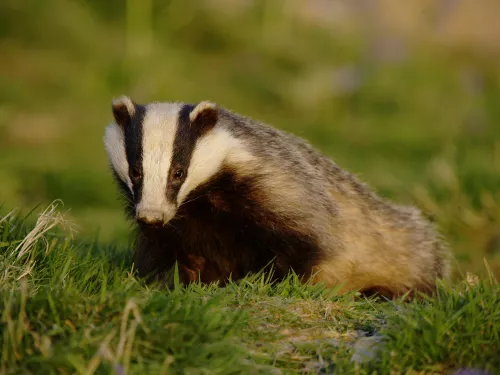
Badgers are the UK’s largest land predator and are one of the most well-known British species. They are famed for their black and white stripes and sturdy body, using their strong front paws to dig for food and to perfect their hobbit-like burrows, called ‘setts’.
The Silver Y migrates to the UK in massive numbers each year - sometimes, an estimated 220 million can reach our shores in spring! Seen throughout the year, it is very common in gardens and grasslands.
Holly is a much-loved evergreen tree - its shiny, spiky leaves and bright red berries being a favourite in Christmas decorations. Found in all kinds of habitats, it provides an important winter food source for birds.
The common shieldbug was once restricted to Southern England, but has since been moving northwards and is now quite widespread. It can be found in all kinds of habitats from gardens to farms.
The hart's-tongue fern is a hardy fern of damp, shady places in woodlands. It also makes a good garden fern. It has simple, tongue-shaped, glossy, green leaves that have orange spores on their undersides.
The grey partridge is an attractive bird that prefers the ground to pear trees! Found on farmland and grassland, it is under threat from loss of habitat.
The bill-shaped seed pods of Common Stork's-bill explode when ripe, sending the seeds flying! This low-growing plant has pretty pink flowers and can be seen on grasslands and coastal sands.
The knopper gall wasp produces knobbly red, turning to brown, growths, or 'galls', on the acorns of Pedunculate Oak. Inside the gall, the larvae of the wasp feed on the host tissues, but cause little damage.
The magpie is a distinctive moth with striking black and yellow spots on white wings. It is a frequent garden visitor, but also likes woodland, scrub and heathland.
Often a lone figure on a windswept mountainside or heath, the Rowan tree can stand for up to 200 years. It is well known for its masses of red berries that attract all kinds of birds, including thrushes.
A summer visitor, the wheatear is a handsome chat, with black cheeks, white eyestripes, a blue back and a pale orange chest. Look for it on upland heaths and moors.
Also known as 'Goldmoss' due to its dense, low-growing nature and yellow flowers, Biting stonecrop can be seen on well-drained ground like sand dunes, shingle, grasslands, walls and pavements.
So-named for its three bull-like horns, the Minotaur beetle is a large dung beetle found on grassland and heathland from the autumn. Adults drag dung back to their nests for their larvae to feed on.
The gatekeeper is on the wing in summer on grasslands, in woodlands and along hedgerows. Look out for the large, distinctive eyespot with two 'pupils' on each forewing.
The blackbird of the mountains, ring ouzels can be found breeding on upland moors and rocky crags in summer.
It’s easy to see where these butterflies get their name – the males have bright orange tips on their wings! See them from early spring through to summer in meadows, woodland and hedges.
The tightly packed, thistle-like purple flower heads of common knapweed bloom on all kinds of grasslands. Also regularly called 'black knapweed, this plant attracts clouds of butterflies.
The wolf spider can be found in a wide range of habitats, including the garden. It hunts down its prey, leaping on it just like a wolf. Spiders are beneficial neighbours, helping to manage garden pests.
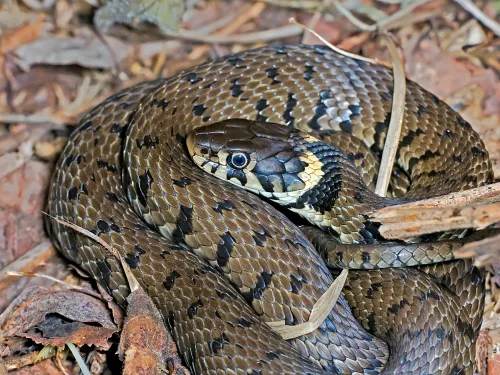
The grass snake is our longest snake, but don't worry if you find one in the compost heap - it's harmless! Look out for this green and yellow beauty in grasslands and wetlands, too.
The small, brown Dartford warbler is most easily spotted when warbling its scratchy song from the top of a gorse stem. It lives on lowland heathland in the south of England, where it nests on the ground.
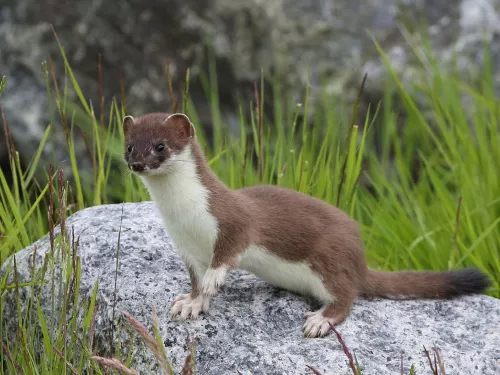
The stoat is a small mustelid, related to the weasel and otter. It has an orange body, black-tipped tail and distinctive bounding gait. Spot it on grassland, heaths and in woodlands across the UK.
The angle shades can be well-hidden among the leaf litter - its pinky-brown markings and scalloped wings giving it the perfect camouflage. It is on the wing in gardens, woods and hedgerows from May.
Annual meadow-grass is a coarse, vigorous grass that can be found on waste ground, bare grassland and in lawns. In some situations, it can be considered a weed.
In spring and summer, look out for 'cuckoo-spit' - the frothy mass of bubbles that appears on plant stems everywhere. This is actually the protective covering for the nymphs of the tiny Common froghopper.
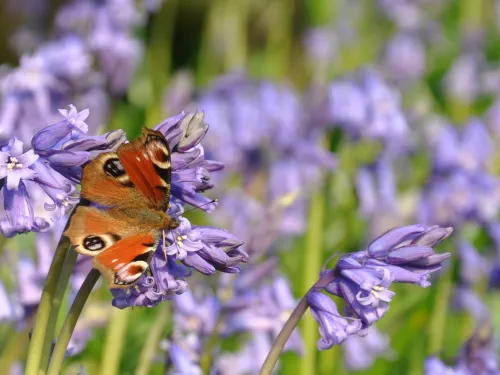
Ancient woodland with heathland and bog
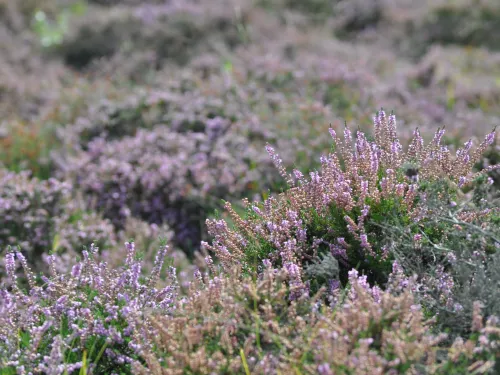
Rich in flora and fauna, this important reserve contains Kent's last four valley bogs and one of its few remaining fragments of open heath.
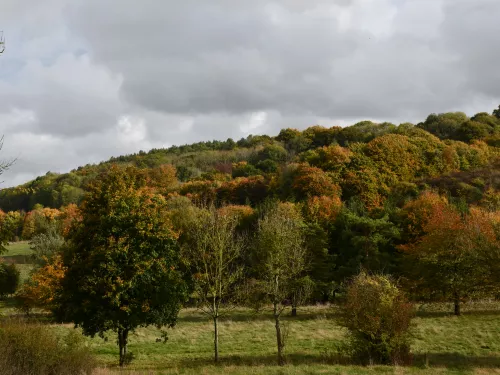
Heather Corrie Vale is located in the Darent Valley, which is an extremely valuable part of the Nature Recovery Network.
